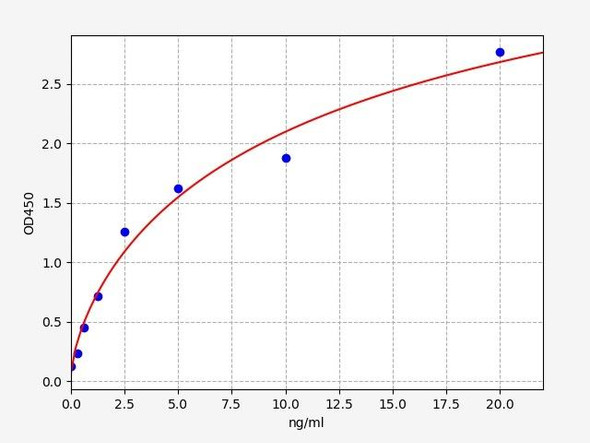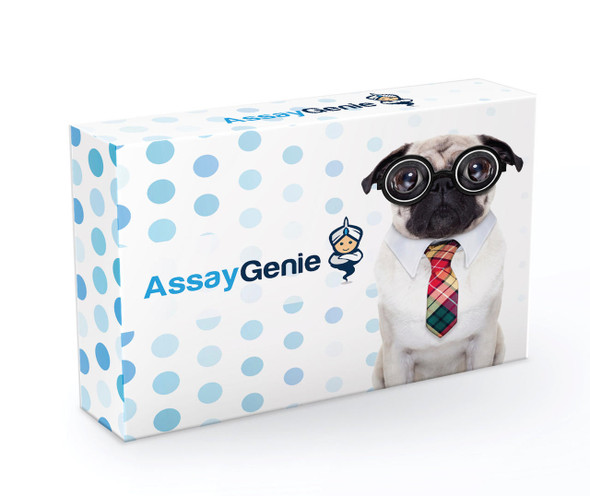Rat Signaling ELISA Kits 3
Rat LIFR (Leukemia Inhibitory Factor Receptor) CLIA Kit (RTES00360)
- SKU:
- RTES00360
- Product Type:
- ELISA Kit
- ELISA Type:
- CLIA Kit
- Size:
- 96 Assays
- Sensitivity:
- 37.5pg/mL
- Range:
- 62.5-4000pg/mL
- ELISA Type:
- Sandwich
- Synonyms:
- CD118, LIF-R, SJS2, STWS, SWS
- Reactivity:
- Rat
- Sample Type:
- Serum, plasma and other biological fluids
Description
| Assay type: | Sandwich |
| Format: | 96T |
| Assay time: | 4.5h |
| Reactivity: | Rat |
| Detection method: | Chemiluminescence |
| Detection range: | 62.50-4000 pg/mL |
| Sensitivity: | 37.50 pg/mL |
| Sample volume: | 100µL |
| Sample type: | Serum, plasma and other biological fluids |
| Repeatability: | CV < 15% |
| Specificity: | This kit recognizes Rat LIFR in samples. No significant cross-reactivity or interference between Rat LIFR and analogues was observed. |
This kit uses Sandwich-CLIA as the method. The micro CLIA plate provided in this kit has been pre-coated with an antibody specific to Rat LIFR. Standards or samples are added to the appropriate micro CLIA plate wells and combined with the specific antibody. Then a biotinylated detection antibody specific for Rat LIFR and Avidin-Horseradish Peroxidase (HRP) conjugate are added to each micro plate well successively and incubated. Free components are washed away. The substrate solution is added to each well. Only those wells that contain Rat LIFR, biotinylated detection antibody and Avidin-HRP conjugate will appear fluorescence. The Relative light unit (RLU) value is measured spectrophotometrically by the Chemiluminescence immunoassay analyzer. The RLU value is positively associated with the concentration of Rat LIFR. The concentration of Rat LIFR in the samples can be calculated by comparing the RLU of the samples to the standard curve.
| UniProt Protein Function: | LIFR: Signal-transducing molecule. May have a common pathway with IL6ST. The soluble form inhibits the biological activity of LIF by blocking its binding to receptors on target cells (By similarity) |
| UniProt Protein Details: | Protein type:Membrane protein, integral; Receptor, cytokine Cellular Component: membrane; integral to membrane; plasma membrane; receptor complex Molecular Function:protein binding; protein heterodimerization activity; oncostatin-M receptor activity; leukemia inhibitory factor receptor activity; cytokine binding; growth factor binding; ciliary neurotrophic factor receptor activity; ciliary neurotrophic factor receptor binding Biological Process: organ regeneration; response to cytokine stimulus; leukemia inhibitory factor signaling pathway; cytokine and chemokine mediated signaling pathway; positive regulation of cell proliferation; response to organic cyclic substance; neurite morphogenesis |
| NCBI Summary: | alpha chain of leukemia inhibitory factor glycoprotein and growth factor [RGD, Feb 2006] |
| UniProt Code: | O70535 |
| NCBI GenInfo Identifier: | 13591979 |
| NCBI Gene ID: | 81680 |
| NCBI Accession: | NP_112310. 1 |
| UniProt Related Accession: | O70535 |
| Molecular Weight: | 13. 3kDa |
| NCBI Full Name: | leukemia inhibitory factor receptor |
| NCBI Synonym Full Names: | leukemia inhibitory factor receptor alpha |
| NCBI Official Symbol: | Lifr |
| NCBI Protein Information: | leukemia inhibitory factor receptor; LIF-R; LIF receptor; leukemia inhibitor factor receptor alpha-chain |
| UniProt Protein Name: | Leukemia inhibitory factor receptor |
| Protein Family: | Leukemia inhibitory factor receptor |
| UniProt Gene Name: | Lifr |
| UniProt Entry Name: | LIFR_RAT |
As the RLU values of the standard curve may vary according to the conditions of the actual assay performance (e. g. operator, pipetting technique, washing technique or temperature effects), the operator should establish a standard curve for each test. Typical standard curve and data is provided below for reference only.
| Concentration (pg/mL) | RLU | Average | Corrected |
| 4000 | 57273 60889 | 59081 | 59046 |
| 2000 | 26528 29190 | 27859 | 27824 |
| 1000 | 14217 12751 | 13484 | 13449 |
| 500 | 6537 6673 | 6605 | 6570 |
| 250 | 3386 3100 | 3243 | 3208 |
| 125 | 1621 1541 | 1581 | 1546 |
| 62.50 | 711 799 | 755 | 720 |
| 0 | 34 36 | 35 | -- |
Precision
Intra-assay Precision (Precision within an assay): 3 samples with low, mid range and high level Rat LIFR were tested 20 times on one plate, respectively.
Inter-assay Precision (Precision between assays): 3 samples with low, mid range and high level Rat LIFR were tested on 3 different plates, 20 replicates in each plate.
| Intra-assay Precision | Inter-assay Precision | |||||
| Sample | 1 | 2 | 3 | 1 | 2 | 3 |
| n | 20 | 20 | 20 | 20 | 20 | 20 |
| Mean (pg/mL) | 202.39 | 415.89 | 1861.79 | 184.30 | 430.63 | 1799.94 |
| Standard deviation | 26.01 | 43.29 | 163.09 | 22.06 | 43.28 | 119.16 |
| C V (%) | 12.85 | 10.41 | 8.76 | 11.97 | 10.05 | 6.62 |
Recovery
The recovery of Rat LIFR spiked at three different levels in samples throughout the range of the assay was evaluated in various matrices.
| Sample Type | Range (%) | Average Recovery (%) |
| Serum (n=5) | 97-112 | 102 |
| EDTA plasma (n=5) | 97-109 | 104 |
| Cell culture media (n=5) | 90-102 | 96 |
Linearity
Samples were spiked with high concentrations of Rat LIFR and diluted with Reference Standard & Sample Diluent to produce samples with values within the range of the assay.
| Serum (n=5) | EDTA plasma (n=5) | Cell culture media (n=5) | ||
| 1:2 | Range (%) | 100-114 | 95-110 | 92-107 |
| Average (%) | 106 | 101 | 98 | |
| 1:4 | Range (%) | 103-119 | 96-111 | 99-113 |
| Average (%) | 110 | 102 | 104 | |
| 1:8 | Range (%) | 86-98 | 99-111 | 90-104 |
| Average (%) | 92 | 105 | 96 | |
| 1:16 | Range (%) | 83-98 | 90-101 | 86-97 |
| Average (%) | 90 | 95 | 91 |
An unopened kit can be stored at 4°C for 1 month. If the kit is not used within 1 month, store the items separately according to the following conditions once the kit is received.
| Item | Specifications | Storage |
| Micro CLIA Plate(Dismountable) | 8 wells ×12 strips | -20°C, 6 months |
| Reference Standard | 2 vials | |
| Concentrated Biotinylated Detection Ab (100×) | 1 vial, 120 µL | |
| Concentrated HRP Conjugate (100×) | 1 vial, 120 µL | -20°C(shading light), 6 months |
| Reference Standard & Sample Diluent | 1 vial, 20 mL | 4°C, 6 months |
| Biotinylated Detection Ab Diluent | 1 vial, 14 mL | |
| HRP Conjugate Diluent | 1 vial, 14 mL | |
| Concentrated Wash Buffer (25×) | 1 vial, 30 mL | |
| Substrate Reagent A | 1 vial, 5 mL | 4°C (shading light) |
| Substrate Reagent B | 1 vial, 5 mL | 4°C (shading light) |
| Plate Sealer | 5 pieces | |
| Product Description | 1 copy | |
| Certificate of Analysis | 1 copy |
- Set standard, test sample and control (zero) wells on the pre-coated plate and record theirpositions. It is recommended to measure each standard and sample in duplicate. Note: addall solutions to the bottom of the plate wells while avoiding contact with the well walls. Ensuresolutions do not foam when adding to the wells.
- Aliquot 100µl of standard solutions into the standard wells.
- Add 100µl of Sample / Standard dilution buffer into the control (zero) well.
- Add 100µl of properly diluted sample (serum, plasma, tissue homogenates and otherbiological fluids. ) into test sample wells.
- Cover the plate with the sealer provided in the kit and incubate for 90 min at 37°C.
- Aspirate the liquid from each well, do not wash. Immediately add 100µL of BiotinylatedDetection Ab working solution to each well. Cover the plate with a plate seal and gently mix. Incubate for 1 hour at 37°C.
- Aspirate or decant the solution from the plate and add 350µL of wash buffer to each welland incubate for 1-2 minutes at room temperature. Aspirate the solution from each well andclap the plate on absorbent filter paper to dry. Repeat this process 3 times. Note: a microplatewasher can be used in this step and other wash steps.
- Add 100µL of HRP Conjugate working solution to each well. Cover with a plate seal andincubate for 30 min at 37°C.
- Aspirate or decant the solution from each well. Repeat the wash process for five times asconducted in step 7.
- Add 100µL of Substrate mixture solution to each well. Cover with a new plate seal andincubate for no more than 5 min at 37°C. Protect the plate from light.
- Determine the RLU value of each well immediately.






